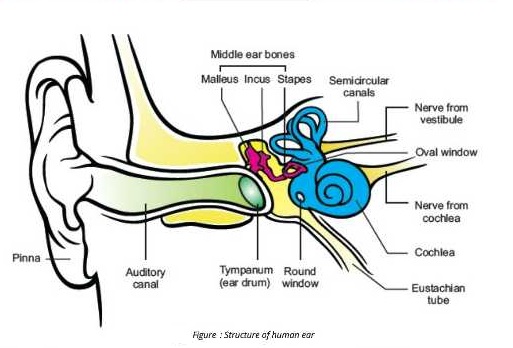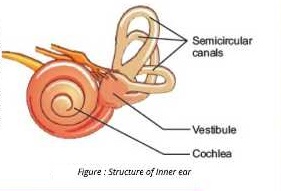Q.11 Explain the structure of human ear in detail. Describe its functioning in balancing of body.
Answer:
Ear
Hearing is as important as vision. Our ear helps us in hearing and also to maintain the balance or equilibrium of our body.
Structure of Ear
Ear has three main parts i.e.
(a) External ear (b) Middle Ear (c) Internal Ear.
(a) External Ear
Parts of external ear
External ear consists of pinna, auditory canal and eardrum (tympanum).
PINNA
Pinna is the broad external part, made of cartilage and covered with skin.
AUDITORY CANAL
Pinna helps to direct sound waves into auditory canal. There are special glands in the walls of auditory canal which produce wax.
Function of hair and wax
The hair and the wax in auditory canal protect ear from small insects, germs and dust. They help to maintain the temperature and dampness of auditory caņal.
EAR DRUM
Auditory canal ends in ear drum. This thin membrane separates external ear from the middle ear.

(b) Middle ear
Middle ear is a chamber after external ear.
Bones
Three small bones, called middle ear ossicles, are present in a chain in middle ear. These moveble bones include malleus, incus and stapes. These three bones are collectively called middle ear ossicles. Malleus
It is attached with eardrum, then comes incus and finally stapes.
Stapes
It is the smallest bone of body.
Oval window
Stapes is connected with a membrane called oval window. Oval window separates middle ear from inner ear. Middle ear also communicates with the nasal cavity through
eustachian tube.
Function of Eustachian tube.
This tube regulates the air pressure on both sides of ear drum. (c) Inner ear Parts of inner Ear
Inner ear consists of three parts i.e. vestibule, semicircular canals and cochlea. Vestibule
It is present in the centre of inner ear.
Semicircular canals :
Three canals called semicircular canals are posterior to the vestibule.
Cochlea
The cochlea is made of three ducts and wraps itself into a coiled tube.
Sound Receptor cells
Sound receptor cells are present within the middle duct of cochlea.

The process of hearing
The pinna of the external ear focuses and directs sound waves into auditory canal. The sound waves strike ear drum and produce vibrations in it. From ear drum, the vibrations strike middle ear and produce further vibrations in malleus, incus and then stapes. From stapes, the vibrations strike the oval window and then reach the fluid-filled middle duct of cochlea. The fluid of cochlea is moved and receptor cells are stimulated. The receptor cells generate a nerve impulse, which travels to brain and is interpreted as sound.
Ears maintain the balance of body
Semicircular canal and vestibule help to maintain the balance of body. Semicircular canals contain sensory nerves which can detect any movement of head. Vestibule can detect any change in the posture of body. The neurons coming from these two receptors reach cerebellum through the auditory nerve.